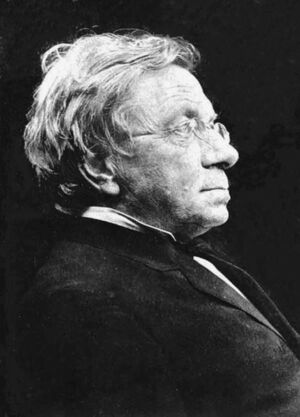Johann Jakob Balmer (nonfiction): Difference between revisions
(Created page with "thumb|Johann Jakob Balmer (circa 1880's).'''Johann Jakob Balmer''' (May 1, 1825 – March 12, 1898) was a Swiss mathematician and mathematical...") |
No edit summary |
||
| Line 1: | Line 1: | ||
[[File:Johann_Jakob_Balmer.jpg|thumb|Johann Jakob Balmer (circa 1880's).]]'''Johann Jakob Balmer''' (May 1, 1825 – March 12, 1898) was a Swiss mathematician and mathematical physicist. | [[File:Johann_Jakob_Balmer.jpg|thumb|Johann Jakob Balmer (circa 1880's).]]'''Johann Jakob Balmer''' (May 1, 1825 – March 12, 1898) was a Swiss mathematician and mathematical physicist. | ||
Despite being a mathematician, he is not remembered for any work in that field; rather, his major contribution (made at the age of sixty, in 1885) was an empirical formula for the visible spectral lines of the hydrogen atom, the study of which he took up at the suggestion of Eduard Hagenbach, also of Basel. | Despite being a mathematician, he is not remembered for any work in that field; rather, his major contribution (made at the age of sixty, in 1885) was an empirical formula for the visible spectral lines of the hydrogen atom, the study of which he took up at the suggestion of [[Eduard Hagenbach-Bischoff (nonfiction)|Eduard Hagenbach-Bischoff]], also of Basel. | ||
Using Ångström's measurements of the hydrogen lines, Balmer arrived at a formula for computing the wavelength. | Using [[Anders Jonas Ångström (nonfiction)|Ångström]]'s measurements of the hydrogen lines, Balmer arrived at a formula for computing the wavelength. | ||
In his 1885 notice, he referred to h (now known as the Balmer constant) as the "fundamental number of hydrogen." Balmer then used this formula to predict the wavelength for m = 7 and Hagenbach informed him that Ångström had observed a line with wavelength 397 nm. Two of his colleagues, Hermann Wilhelm Vogel and William Huggins, were able to confirm the existence of other lines of the series in the spectrum of hydrogen in white stars. | In his 1885 notice, he referred to ''h'' (now known as the Balmer constant) as the "fundamental number of hydrogen." Balmer then used this formula to predict the wavelength for ''m'' = 7 and [[Eduard Hagenbach-Bischoff (nonfiction)|Hagenbach]] informed him that [[Anders Jonas Ångström (nonfiction)|Ångström]] had observed a line with wavelength 397 nm. Two of his colleagues, [[Hermann Wilhelm Vogel (nonfiction)|Hermann Wilhelm Vogel]] and [[William Huggins (nonfiction)|William Huggins]], were able to confirm the existence of other lines of the series in the spectrum of hydrogen in white stars. | ||
Balmer's formula was later found to be a special case of the Rydberg formula, devised by Johannes Rydberg. | Balmer's formula was later found to be a special case of the Rydberg formula, devised by [[Johannes Rydberg (nonfiction)|Johannes Rydberg]]. | ||
A full explanation of why these formulas worked, however, had to wait until the presentation of the Bohr model of the atom by [[Niels Bohr (nonfiction)|Niels Bohr]] in 1913. | A full explanation of why these formulas worked, however, had to wait until the presentation of the Bohr model of the atom by [[Niels Bohr (nonfiction)|Niels Bohr]] in 1913. | ||
| Line 17: | Line 17: | ||
== Fiction cross-reference == | == Fiction cross-reference == | ||
* [[Crimes against physical constants]] | |||
* [[Gnomon algorithm]] | |||
* [[Mathematics]] | |||
== Nonfiction cross-reference == | == Nonfiction cross-reference == | ||
* [[Anders Jonas Ångström (nonfiction)]] | |||
* [[Niels Bohr (nonfiction)]] | |||
* [[Eduard Hagenbach-Bischoff (nonfiction)]] | |||
* [[William Huggins (nonfiction)]] - colleague | |||
* [[Physics (nonfiction)]] | * [[Physics (nonfiction)]] | ||
* [[Johannes Rydberg (nonfiction)]] | |||
* [[Hermann Wilhelm Vogel (nonfiction)]] - colleague | |||
External links: | External links: | ||
Latest revision as of 13:51, 26 December 2017
Johann Jakob Balmer (May 1, 1825 – March 12, 1898) was a Swiss mathematician and mathematical physicist.
Despite being a mathematician, he is not remembered for any work in that field; rather, his major contribution (made at the age of sixty, in 1885) was an empirical formula for the visible spectral lines of the hydrogen atom, the study of which he took up at the suggestion of Eduard Hagenbach-Bischoff, also of Basel.
Using Ångström's measurements of the hydrogen lines, Balmer arrived at a formula for computing the wavelength.
In his 1885 notice, he referred to h (now known as the Balmer constant) as the "fundamental number of hydrogen." Balmer then used this formula to predict the wavelength for m = 7 and Hagenbach informed him that Ångström had observed a line with wavelength 397 nm. Two of his colleagues, Hermann Wilhelm Vogel and William Huggins, were able to confirm the existence of other lines of the series in the spectrum of hydrogen in white stars.
Balmer's formula was later found to be a special case of the Rydberg formula, devised by Johannes Rydberg.
A full explanation of why these formulas worked, however, had to wait until the presentation of the Bohr model of the atom by Niels Bohr in 1913.
In the News
Fiction cross-reference
Nonfiction cross-reference
- Anders Jonas Ångström (nonfiction)
- Niels Bohr (nonfiction)
- Eduard Hagenbach-Bischoff (nonfiction)
- William Huggins (nonfiction) - colleague
- Physics (nonfiction)
- Johannes Rydberg (nonfiction)
- Hermann Wilhelm Vogel (nonfiction) - colleague
External links:
- Johann Jakob Balmer @ Wikipedia
